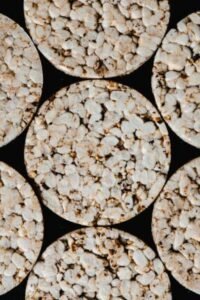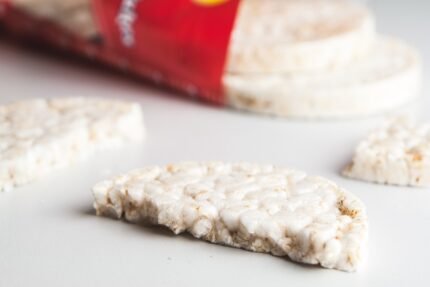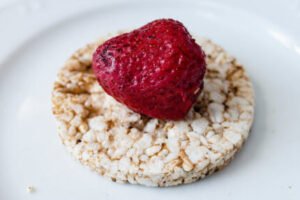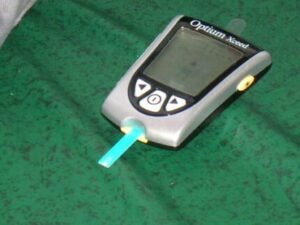Medically reviewed by Dr. Ramesh Gaddam, M.D. — Written by Sumalatha, D.N.H.E
Table of Contents
ToggleRice cakes don’t have gluten because they’re made from rice, which is naturally gluten-free. This is good for people who can’t eat gluten. But sometimes, during making or packing, rice cakes might touch gluten foods, so they could get a little gluten on them.
People who are very sensitive to gluten should look for rice cakes that say “gluten-free” on the package to be safe. Always check the labels to make sure they’re okay for you to eat.
Nutrition of Rice Cakes
Nutrition of plain rice cakes:
| Nutrient | Amount per Rice Cake |
|---|---|
| Calories | 35-40 kcal |
| Carbohydrates | 7-9 grams |
| Protein | 0-1 gram |
| Fat | 0 grams |
| Fiber | 0-1 gram |
| Sodium | 0-20 milligrams |
Benefits of Rice Cakes
Low in Calories:
Rice cakes have few calories, so they’re great for snacking without worrying about gaining weight.
No Gluten:
Rice cakes don’t have gluten, which is good for people who can’t eat gluten because of allergies or other reasons.
Low Fat:
Rice cakes are low in fat, so they’re a good choice if you’re trying to eat healthier.
Easy to Add Toppings:
You can add a lot of different things on rice cakes, like peanut butter or fruit, to make them tasty.
Convenient to Carry:
Rice cakes come in individual packs, so you can take them with you wherever you go.
Keep You Full:
Even though they’re low in calories, rice cakes can help you feel full between meals.
Whole Grain Options:
Some rice cakes are made with whole grains, which have more nutrients and fiber than regular rice cakes.
Safe for Allergies:
Rice cakes don’t have common allergens like nuts or dairy, so they’re safe for most people to eat.
Fit Different Diets:
Whether you’re vegan, gluten-free, or on a specific diet, rice cakes can usually be part of your eating plan.
Ingredients in Rice Cakes
Some common additional ingredients found in rice cakes:

Salt
Salt is often added to rice cakes to make them taste better.
If you’re trying to eat less salt, it’s important to check how much salt is in the rice cakes.
Flavorings
Rice cakes can have different flavors added to them.
These flavors can be natural or artificial. Some taste like cheese or barbecue, while others are sweet, like chocolate or caramel.
Additives for Texture
Some rice cakes have things added to them to change how they feel in your mouth.
These might include maltodextrin or modified food starch, which makes them crunchy or smooth.
Preservatives
To make rice cakes last longer, manufacturers sometimes add preservatives.
These are things that keep the rice cakes from spoiling.
Common preservatives include tocopherols (which is just a fancy word for vitamin E) or citric acid.
Sweeteners
If you’re eating sweet rice cakes, they might have sugar or corn syrup added to them.
These make the rice cakes taste sweeter. Just be careful if you’re trying to cut down on sugar.
Oil
Most rice cakes don’t have any fat in them, but flavored ones might have a little bit of oil.
This is to help spread the flavor around or stop the rice cakes from sticking together.
Choose rice cakes carefully by reading the ingredients. Look for fewer additives. Make sure they’re gluten-free if you can’t have gluten.
Certification and Labeling:
In the United States and Europe, food makers must follow rules about labeling gluten-free products.
Some rice cake brands have a gluten-free label from trusted groups, which helps people with gluten issues feel confident.
But it’s smart to double-check the ingredients and how they’re made to be sure they’re right for you.
Cross-Contamination Concerns:
Even if rice cakes don’t have gluten, they might touch it during production.
Factories making rice cakes may handle gluten, so some could get into the rice cakes.
People with gluten sensitivity should ask makers how they make rice cakes to be sure.
Uses of Rice Cakes
Rice cakes offer various applications, serving as snacks, meal components, party appetizers, and dietary substitutes.

Snacking:
Rice cakes are a popular choice for snacks. They’re light, crunchy, and can be eaten alone or with toppings.
Toppings:
You can put lots of different things on rice cakes, like peanut butter or cheese. They’re like a blank canvas for flavors.
Meal Replacement:
If you’re not too hungry, rice cakes with protein on top can be a light meal.
Dietary Substitution:
For people with special diets, like gluten-free or vegan, rice cakes can be a good alternative to other snacks or bread.
On-the-Go Snack:
Rice cakes come in different packs, so they’re easy to carry when you’re out and about.
Party Appetizers:
You can make fancy appetizers by topping rice cakes with tasty ingredients for parties or gatherings.
Dessert Base:
Rice cakes aren’t just for savory snacks – you can top them with sweet stuff like chocolate or fruit for dessert.
Weight Management:
Because they’re low in calories and fat, rice cakes are good for people watching their weight.
Post-Workout Snack:
After exercising, rice cakes with protein toppings can help your muscles recover.
Children’s Snacks:
Kids like rice cakes because they’re crunchy and mild. You can even add fun toppings for them to enjoy.
Rice cakes are awesome because they are versatile and easy to use in many different situations. You can eat them with anything and it will still be delicious!
Are rice cakes healthy?
Low in Calories:
Rice cakes have few calories, which can be good if you’re watching your weight.
Gluten-Free Option:
If you can’t eat gluten, rice cakes are a good choice because they don’t have any.
Versatile Snack:
You can put healthy things on rice cakes, like fruits or vegetables, to make them healthier.
Watch Portion Sizes:
Even though rice cakes are low in calories, eating too many isn’t good for you.
Some Downsides:
Flavored rice cakes might have added sugar or salt, which aren’t so healthy.
Balanced Diet:
Rice cakes can be part of a healthy diet, but you should also eat other nutritious foods too.
Side Effects of Rice Cakes
Digestive Issues:
Eating too many rice cakes can cause digestive problems like bloating or discomfort due to their high carbohydrate content.
Blood Sugar Spikes:
Since rice cakes are high in carbohydrates, they can cause blood sugar levels to spike quickly, especially if eaten alone without protein or fiber.
Nutrient Deficiencies:
Rice cakes lack many essential nutrients, so relying on them as a primary food source may lead to deficiencies in vitamins, minerals, and protein.
Cross-Contamination Risks:
Despite being gluten-free, rice cakes can still be at risk of cross-contamination during production, which may pose problems for those with severe gluten sensitivities.
Weight Gain:
While low in calories, overconsumption of rice cakes without considering overall dietary balance can contribute to weight gain due to their high carbohydrate content.
Sodium Intake:
Some flavored rice cakes may contain high amounts of added salt, leading to increased sodium intake, which can be harmful, especially for individuals with high blood pressure or heart conditions.
Dental Health:
The sticky nature of some rice cake toppings, especially sweet ones, can adhere to teeth and contribute to dental decay if proper oral hygiene is not maintained.
Lack of Satiety:
Despite being crunchy, rice cakes may not provide long-lasting feelings of fullness or satiety, leading to overeating or snacking on additional high-calorie foods.
Allergic Reactions:
Although rare, some individuals may be allergic to specific ingredients in rice cakes or their toppings, leading to allergic reactions such as hives, itching, or anaphylaxis.
Contaminants:
Depending on the manufacturing process, rice cakes may contain traces of contaminants like heavy metals or pesticides, which can pose health risks if consumed regularly over time.
Are rice cakes good for diabetics?
Rice cakes can be a suitable snack option for individuals with diabetes, but like any food, moderation and consideration of their impact on blood sugar levels are important.
Here are some points to consider regarding rice cakes and diabetes:
Low Glycemic Index (GI)
Plain rice cakes typically have a low glycemic index, meaning they cause a slower and more gradual increase in blood sugar levels compared to high-GI foods.
This can be beneficial for managing blood glucose levels in individuals with diabetes.
Portion Control
While rice cakes are low in calories and carbohydrates, it’s essential to be mindful of portion sizes.
Eating excessive amounts of rice cakes can still lead to spikes in blood sugar levels, especially if they’re flavored or have added sugars.
Pairing with Protein or Healthy Fats
To help mitigate any potential spikes in blood sugar, individuals with diabetes can pair rice cakes with protein or healthy fats.
For example, topping rice cakes with nut butter or avocado can slow down the digestion of carbohydrates and provide a more balanced blood sugar response.
Choosing Whole Grain Varieties
Opting for whole grain rice cakes can provide additional fiber, which can further help regulate blood sugar levels and promote satiety.
Monitoring Blood Glucose Levels
It’s essential for individuals with diabetes to monitor their blood glucose levels regularly, especially when trying new foods like rice cakes.
This helps them understand how different foods affect their individual blood sugar responses.
Consultation with a Healthcare Professional
Individuals with diabetes should consult with a registered dietitian or healthcare professional to ensure that rice cakes fit into their overall meal plan and dietary goals.
Frequently Asked Questions
Here’s what you need to know about the FAQs of rice cakes.
Are Rice Cakes Good for Weight Loss?
Rice cakes can be part of a weight loss plan because they’re low in calories and fat.
However, they’re not a magic solution. It’s important to eat a balanced diet and watch portion sizes.
Including protein and fiber-rich toppings can help keep you full longer and support weight loss goals.
How many rice cakes can I eat a day?
The number of rice cakes you can eat depends on your individual dietary needs and goals.
It’s best to consult with a healthcare professional or dietitian for personalized advice.
Are rice cakes full of sugar?
Plain rice cakes typically contain minimal sugar, but flavored varieties may have added sugars.
Check the nutrition label to see the sugar content and choose options with minimal added sugars.
Is rice cake better than bread?
Rice cakes and bread have different nutritional profiles.
Rice cakes are lower in calories and fat, but bread may provide more fiber and nutrients.
Choose based on your dietary preferences and needs.
Why do gym people eat rice cakes?
Gym-goers may eat rice cakes as a quick source of carbohydrates for energy before or after workouts.
Rice cakes are light and easy to digest, making them convenient for active individuals.
Are rice cakes easy to digest?
Yes, rice cakes are generally easy to digest due to their simple ingredients and light texture.
They can be a gentle option for those with sensitive stomachs.
How many calories are in a rice cake?
A plain rice cake typically contains around 35 to 40 calories.
Flavored varieties may have slightly more calories due to added ingredients.
Can I eat rice cakes after a workout?
Yes, you can eat rice cakes after a workout to replenish glycogen stores and provide quick energy.
Pairing them with protein can enhance muscle recovery.
Also, read in detail: Are rice cakes healthy?
Medically reviewed by Dr. Ramesh Gaddam, M.D.

General Physician, Diabetologist, and Critical Care Specialist.
Related
Discover more from Health Build-Up
Subscribe to get the latest posts sent to your email.



